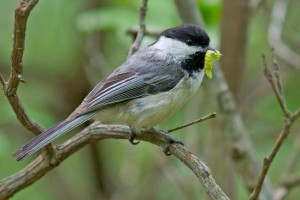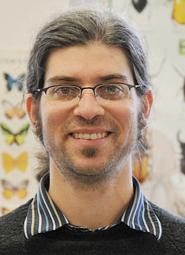Birds Seek Caterpillars on Nutritious Trees, Says Biology Researchers

A word of caution to the caterpillar munching on that delicious, nutritious black cherry tree: watch out for hungry birds.
Michael Singer, associate professor of biology, is the lead author of a new study published in The American Naturalist on the effect of a caterpillar’s choice of feeding spot on its chances of becoming bird food. The article found that on balance, nutritious trees, like black cherry, can increase by 90 percent a caterpillar’s risk of being taken by foraging birds. According to the article, this effect is seen because the most nutritious tree species harbor the greatest number of caterpillars, offering up the easiest pickings for birds. Unfortunately for caterpillars, feeding on less crowded, nutritionally poor trees, like American beech, also carries risk by slowing down a caterpillar’s growth and prolonging its exposure to bird predation.
The article was co-authored by two former Wesleyan students—Tim Farkas ’08, MA ’10 and Christian Skorik ’09, MA ’10—and researchers at the University of California at Irvine. Numerous undergraduates in the Hughes summer research program assisted with the field experiment in Connecticut forests over a period of two years.

By suggesting that insect-feeding birds forage in response to the type of tree as much as to characteristics of their caterpillar prey, this research also raises questions about how much attention songbirds pay to tree type in choosing nesting sites. It’s possible that an abundance of caterpillar snacks for their babies could entice birds to call more nutritious trees home.
Beyond answering basic theoretical questions in ecology, the study has important practical implications for wildlife conservation and forest health. “Our study shows how specific trees are linked to breeding insectivorous birds—mostly migratory songbirds—through caterpillars. A forest manager or bird conservation biologist can use this information to help promote the survival of songbirds,” explained Singer. “For example, caterpillar forage for spring-breeding songbirds seems to be enriched by black cherry trees, which occur in early to middle stages of forest succession. A forest manager can ensure that timber harvesting and other activities maintain some of this habitat type.”
According to Singer, this study’s findings also dovetail with research being conducted by others on possible large-scale shifts in Northeast forest composition from a canopy dominance of oaks and hickories to a dominance of beech and red maple. The Wesleyan/ UC Irvine study found that beech and red maple offered more limited caterpillar forage to birds, meaning changes in forest composition could threaten the region’s breeding songbirds.
Skorik first got involved in this study during his sophomore year at Wesleyan, having just declared a biology major. He felt it was a good time to begin participating in research and was passionate about working outside with natural animal populations. Skorik recalled, “After a brief discussion with Prof. Singer, I knew that I would become fascinated with the research going on in his lab. I think what drew me to caterpillars was the idea that they are easy to overlook, being so small and silent, and yet they have enormously complex lives with bizarre behaviors and interactions with other organisms.”
Skorik found that he loved fieldwork, which involved surveying trees at a number of local sites for caterpillars most days of the week. “We collected many caterpillars and took them back to the lab so we could feed them daily and raise them to maturity,” he said. “We also pinned and preserved many adult moths and butterflies.”
Skorik said that in analyzing the data, “I remember being dumbfounded by the complexity of our dataset. You’d think that our study system would generally be simple—caterpillar eats leaf, bird eats caterpillar, end of story—but remarkably, each species of tree had a different associated set of caterpillar species living on it, and each caterpillar species suffered to a different degree of bird predation. What seemed like a relatively simple natural system quickly ballooned into complexity.”
Skorik currently works at a startup biotechnology company called bluebird bio. He is presently helping to develop cures for two severe genetic disorders: Adrenoleukodystrophy, and Beta Thalassemia.
He said though his college research experience was in a seemingly unrelated field, “I find that the biology major at Wesleyan prepared me remarkably well for a career in biotechnology. Through my undergraduate and graduate research at Wesleyan, I learned how to search scholarly journals, critically evaluate research, perform complex statistical analyses, and complete large numbers of time-sensitive tasks. My experience using computers and digital cameras gave me an edge in adapting to new technology, so I quickly adapted to using qPCR machines, ELISA (Enzyme-Linked Immunosorbent Assay) plate readers, and microscopes. And, as work with insects involves the detail-oriented manipulation of tiny, delicate insects, I was excellently suited to make fine measurements of liquids using pipettes, and my work in Wesleyan’s greenhouses gave me a foundation of knowledge to learn how to grow live cultures of cells.”

